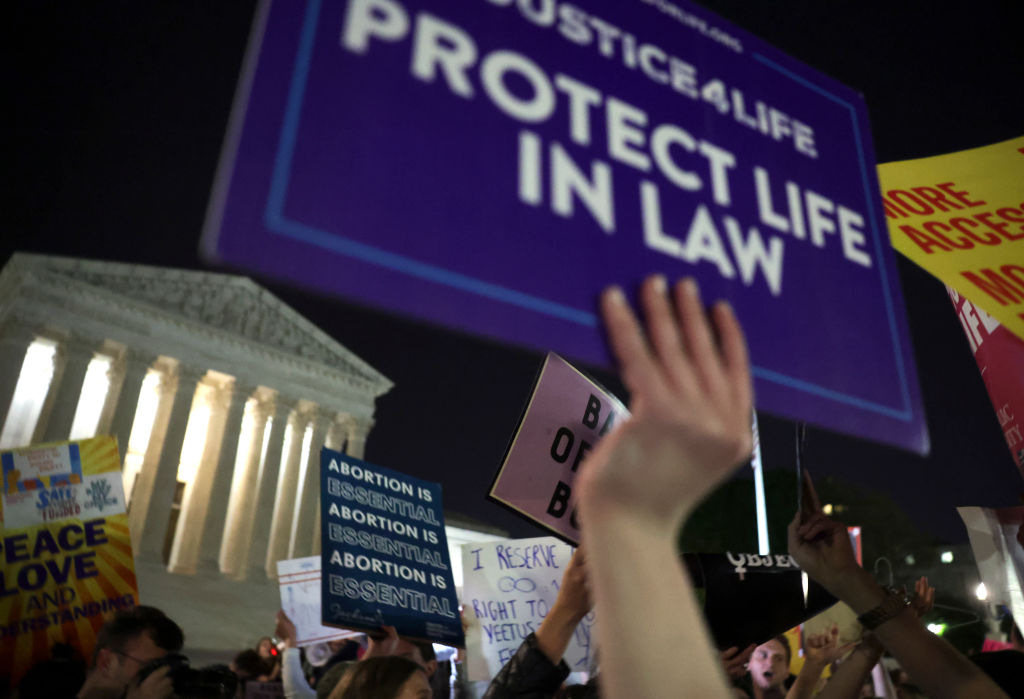
WASHINGTON, DC – MAY 02: Demonstrators gather outside of the U.S. Supreme Court on May 02, 2022 in Washington, DC. In an initial draft majority opinion obtained by Politico, Supreme Court Justice Samuel Alito allegedly wrote that the cases Roe v. Wade and Planned Parenthood of Southeastern v. Casey should be overruled, which would end federal protection of abortion rights across the country. (Photo by Kevin Dietsch/Getty Images)
A first draft of a Supreme Court majority opinion overturning Roe v. Wade and Planned Parenthood of Southeastern Pa. v. Casey has allegedly been leaked. Within minutes, barricades were erected around the Court, and protesters with prepared signs began arriving. Activists and lawmakers on both sides of the issue have prepared for this moment for months, and even though this supposed first draft isn’t the final ruling and might never be, everyone with an interest seems ready for action. With SCOTUS seemingly poised to eliminate the federal abortion access protection, what happens now?
Politico first published the 98-page initial draft of an opinion for Dobbs v. Jackson Women’s Health Organization, a case challenging Mississippi’s 15-week abortion ban, claiming to have received it from “a person familiar with the court’s deliberations.” The opinion is written by Justice Samuel Alito, and Justices Clarence Thomas, Neil Gorsuch, Brett Kavanaugh, and Amy Coney Barrett are all said to have voted with him when they held a conference just after oral arguments in December. The line-up remains unchanged as of this week, the unnamed leaker claims. Justices Stephen Breyer, Sonia Sotomayor, and Elena Kagan – the three Democrat-appointed justices – are supposedly working on one or more dissents, and Chief Justice John Roberts is up the air. Mike Valerio of CNN tweeted that other sources say Roberts does not want to completely overturn Roe, but that he is willing to uphold the Mississippi law originally in question in this case. Regardless of where the chief justice falls, if five out of nine stand behind Alito’s wording, Roe and Casey are finished.
Justice Alito makes it clear in no uncertain terms that both prior rulings must be discarded. “Allowing Mississippi to prohibit abortions after 15 weeks of pregnancy, they argue, ‘would be no different than overruling Casey and Roe entirely’ … They contend that ‘no half-measures’ are available and that we must either reaffirm or overrule Roe and Casey …” he writes of those arguing against Mississippi’s law. But ultimatums are dangerous. “We hold that Roe and Casey must be overruled,” Alito’s opinion – allegedly backed by another four justices – responds.
The State of the States

Assuming the votes and the core idea of the draft don’t change by the time a final ruling is released – initially expected in June, though one wonders if this leak accelerates the timeline – it means the end of federally protected abortion access. As Alito points out, 26 states asked for Roe to be overturned, and are standing by with laws to restrict or even outright ban abortion should this opinion be made official. Some other states, like California, have been busy as well. Golden State lawmakers have been planning for months. Bills expanding access, protecting providers from out-of-state lawsuits, and funding travel for out-of-state patients are already in the works.
At the state level, the end result will be – rather ironically, given the name of the party opposed to states’ rights on this issue – quite democratic. Rather than a federal restriction on state action instituted by nine people in the Swamp, abortion access will be regulated by state lawmakers and governors, who have to face the people in local elections after making these rules. Democracy, of course, isn’t when a Democrat gets his or her way, but when the majority gets its way. Sometimes you’re on that team; sometimes you aren’t. Therefore, states with more anti-abortion voters will maintain more pro-life legislators and, through them, prohibitions against elective termination.
Time for Congress to Act?
Senator Bernie Sanders (I-VT) was quick to tweet his reaction:
“Congress must pass legislation that codifies Roe v. Wade as the law of the land in this country NOW. And if there aren’t 60 votes in the Senate to do it, and there are not, we must end the filibuster to pass it with 50 votes.”

(Photo by Kevin Dietsch/Getty Images)
That knee-jerk reaction was shared by many on the left, as was the suggestion that it’s time to pack the Supreme Court. But there’s a problem here. Democrats don’t have even 50 votes to eliminate the filibuster or pack the courts, as every Republican and at least two Democrats have been reliably against both. Let us imagine a world without the filibuster, however. Sen. Joe Manchin (D-WV), who ran as an anti-abortion Democrat with the Democrats for Life of America, wouldn’t likely support a bill to codify Roe v. Wade in federal law. The senators to watch are Lisa Murkowski (R-AK) and Susan Collins (R-ME). Depending on what a proposed bill would do beyond simply legislate Roe, they quite easily could cross the aisle and bring the Democrats to a 51-49 win, with Manchin the only Democrat siding with the other 48 Republicans. They introduced such a bill of their own, after all, back in February.
Now let’s accelerate the timeline and look to a future GOP trifecta. Democrats nuke the filibuster, codify abortion access protection at the federal level, and add four or five more progressive justices to the Supreme Court. What stops Republicans from adding justices of their own at whatever rate they prefer and banning abortion outright nationwide in that version of America? Officials of both parties have certainly demonstrated a proclivity for tit-for-tat politics over the last several years.
A State Issue Is a State Issue
But would the courts – especially SCOTUS – uphold any such law from either side? Justice Alito’s draft concludes:
“We end this opinion where we began. Abortion presents a profound moral question. The Constitution does not prohibit the citizens of each State from regulating or prohibiting abortion. Roe and Casey arrogated that authority. We now overrule those decisions and return that authority to the people and their elected representatives.
“The judgment of the Fifth Circuit is reversed, and the case is remanded for further proceedings consistent with this opinion.
“It is so ordered.”
That certainly seems clear enough: Whether the majority on the Court find abortion to be right or wrong, it’s entirely an issue for the states to decide.
Remember to check out the web’s best conservative news aggregator
Whatfinger.com — the #1 Alternative to the Drudge

